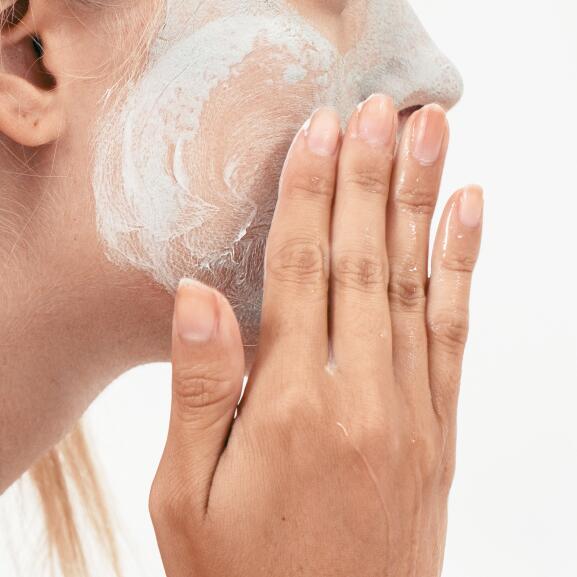Everything you need to know about acne
Everything you need to know about acne
An acne spot isn’t something you can get rid of in a day! There are several stages in the formation of these microcyst, comedo and inflammatory lesions on the face, back, neck and chest, which begin during puberty but also occur into adulthood. Let's take a closer look.

The spot is the tip of the iceberg!
There are four phases in the formation of an acne blemish: overproduction of sebum, skin thickening, the formation of blackheads and comedones and, finally, the inflammation. What triggers acne? Especially when they are misused by skin enzymes (such as during puberty and times of stress), hormones stimulate sebum secretion and make the skin oilier. The top layer of skin thickens due to the increase in free fatty acids and becomes sticky. The pilosebaceous follicles (sacs located at the level of the skin) fill with cells and sebum which turn black on contact with the air: these are blackheads.
C. Acnes bacteria then cause inflammation in these areas, leading to the formation of pimples, pustules (whiteheads), as well as cysts and nodules.
Learn more about the causes of acne
In acne, the sebaceous gland is blocked by sebum that has become too thick or is secreted in too large a quantity. In addition, the cells at the entrance to the pilosebaceous follicle behave abnormally and there is an imbalance in the skin flora.
French Society of Dermatology
Whiteheads: everything you need to know about facial microcysts
Facial micro-cysts are also called closed comedones. They mainly develop on the cheeks, forehead, chin and around the lips. What's that little whitish ball you can feel under your skin? It's a sign of excess sebum secretion. The starting point for its formation is the pilosebaceous follicles, which are partly composed of sebaceous glands. When the concentration of sebum is at its highest and the stratum corneum becomes thick, the small cluster under the skin implodes. At this stage, the pimple either disappears spontaneously or becomes inflamed when excess sebum increases the secretion of Cutibacterium Acnes bacteria. In case of redness, pustules and abscesses appear. There's a lot going on underneath acne-prone skin..

The end of an acne pimple’s life
Once a pimple has formed, how do you get rid of it?
All pimples will eventually disappear: over a period of days to weeks, the macrophages (immune cells) will activate the cleansing phase. What’s their role? They remove the skin tissue damaged by the pimple.
To get rid of your acne pimples, clean your pores to limit oil build-up and inflammation, and make an appointment with a dermatologist for advice on daily treatment.
FRIENDLY (AND EXPERT) ADVICE
Care and hygiene are your friends!
A few good habits to combat imperfections.
Cleanse your skin twice a day and remove your make-up every night.
Shelve all your harsh cleansing products! Harsh products stimulate sebum secretion, encouraging and aggravating the appearance of acne. Opt instead for more suitable gentle cleansing gels.
Avoid picking at your blemishes. This will limit the risk of a pimple forming, or a bacterial secondary infection if you already have a pimple. Don't squeeze your spots, either: impurities may penetrate deeper into your skin and scars may appear.
The right care for acne-prone skin
Skin renewal is essential in protecting against scarring. A good skincare routine is the best way to boost this natural process. Apply an absorbing and exfoliating mask once or twice a week: these products contain moisturizing agents that soothe and purify the skin and encourage cell renewal. Masks also limit sebum build-up and shine. If your skin is fragilized, use a thermal spring water compress.

Our solutions for taking care of your acne-prone skin
Eau Thermale Avène skin care products designed to help you feel better about your skin
- Avène Thermal Spring Water Spray
Best Seller
Thermal Spring Water
Avène Thermal Spring Water SpraySoothes - Restores the skin barrier - Calms
NEWSLETTER
We’re always here for your skin!
All our tips for taking care of your skin day to day.

Which skin care routine should you adopt?
Identify what it really needs with the help of our experts and discover the most suitable skin care routine for you.


